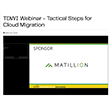
AI ROI Hinges On Addressing New Challenges While Rectifying Old Ones

(MUNGKHOOD STUDIO/Shutterstock)
While some early adopters have reaped the rewards of AI, the majority of enterprises are struggling to see meaningful ROI from their investments in the technology. A recent Axios study revealed that, while 73 percent of C-level executives believe their company’s approach to AI is well-controlled and highly strategic, just 47 percent of the workforce agrees. This disconnect highlights a critical gap that exists between executive perception and enterprise reality; in most cases, deciphering how to measure AI ROI is still not well defined.
Furthermore, some headline-grabbing products marketed as revolutionary AI-powered solutions have fallen short when it comes to delivering tangible business value thus far. An article from Salesforce Ben, a leading independent resource and community site for Salesforce professionals, cites implementation issues and a lack of compelling B2B use cases as common barriers to achieving ROI. As one contributor to the article describes, “Everyone’s showing the same kinds of demos: book a table, return a dress. What we need are real B2B scenarios….”
Therein lies the secret to true AI ROI: applying it to the right use cases.
Provocatively, early indicators are that the sweet spot for enterprise AI are greenfield use cases when it is used to automate historically dark and poorly managed business processes. These use cases are not abundantly clear at the C-level; while the problem space is vast, it is also dark. When properly applied, AI excels at automating the hidden, manual, and often undocumented workflows that occur behind the scenes—tasks that are essential for keeping the business running, but rarely show up in dashboards or organizational charts. These processes are ideal candidates for AI transformation because they’re inefficient, error-prone, and invisible to leadership until something breaks or goes awry.
Presently, the C-suite’s expectations for AI ROI are built on false foundations of confidence: They believe (or assume) their AI strategy will deliver business value, but they haven’t done the work necessary to identify the long-standing challenges to which it should be applied. Achieving meaningful ROI will require executives to conduct a thoughtful exploration and analysis of the “invisible” processes that keep the business running every day, and are taken for granted as the only possible way to get the work done, and introduce automation where it’s needed most. In doing so, they have the ability to make their most valuable employees much more efficient and impactful to the organization.
Let’s examine the limitations of AI when applied to “old” problems, and what’s possible when the technology is thoughtfully applied to the right use cases.
Revisiting Old Challenges: A Recipe for Stagnation and Limited ROI
The first wave of AI adoption in the enterprise is often via existing suppliers that have sprinkled AI on top of their current product suites. But in terms of impact and overall AI strategy, this is creeping incrementalism at best and vaporware at worst.
Picture a sales enablement capability that infuses generative AI into prospecting tools. The capability delivers rapid creation of copy with improved grammar and structured content that sales representatives send to their prospects. But because the AI is choosing the optimal, standard language for what it is being prompted to write, it eliminates any differentiation and novelty from reps’ emails, achieving wasted effort and lower performance in an automated fashion.
This begs the question: Is the company’s goal to create grammatically correct, well-written, standardized copy for sales emails? Or, is the goal to attain a better attach rate and open rate? These are two different business objectives.
While AI can certainly achieve the former, the latter is far more nuanced. Too often, the C-suite evaluates AI-driven tools through the lens of narrow, isolated process improvements, versus their potential to solve broader, strategic challenges. This disconnect occurs when executives lack a deep understanding of the business and its processes; and it is precisely why applying AI to “old” problems won’t result in meaningful ROI.
Uncovering New Challenges: Where AI’s Real ROI Lies
Applying AI successfully demands an intensive exercise in business process discovery. Legal scholar Lawrence Lessig notably said, “Blindness becomes our common sense. And the challenge for anyone who would reclaim the right to cultivate our culture is to find a way to make this common sense open its eyes.”
Applying this concept to the enterprise, “blindness” refers to a company’s inability to see new possibilities and ways of approaching long-standing business problems. Over time, organizations come to accept facts surrounding certain processes as “laws of physics,” e.g., “Our monthly close takes three days, our quarterly close takes two weeks, and that’s just the way it is.” They’ve worked on optimizing these processes over the course of years or decades, and believe they’ve exhausted all of their options to improve them. However, taking a page from Lessig, the C-suite needs to “open its eyes” to new possibilities enabled by AI.
For example, our own organization recently re-examined how we close our books. While exploring this high-impact challenge, we identified one part of the process that was demanding up to 50 hours of our senior finance manager’s time each month. We reverted to first-principles, took the time and care to understand the process in detail, and then applied an agentic AI approach. As a result, we were able to eliminate approximately 95 percent of the dwell time in the process and cut it to just five hours per month.
This use case was successful for the reasons previously mentioned: 1). It entailed automating a dark business process. This wasn’t a documented or described process; there was simply a cultural understanding in our organization that our senior finance manager handles reconciliation so we can close our books. 2). It was a greenfield use case: There was no out-of-the box solution or product that enabled us to support this specific process. We had to discover it ourselves, map it in deep granularity, and apply an agentic AI approach as appropriate. Excitingly, with this experience in hand our Finance team’s eyes are open. In a recent post-close retrospective, the team identified nearly 30 additional potential AI use cases!
Examples such as this one are where enterprises will experience true ROI on their AI investments. Whether it’s applying the technology to automate financial closing, customer acquisition, human capital management, product innovation, or any other number of processes, AI success starts with the C-suite investigating the potential of what’s possible.
Executives must strive to gain a deeper understanding of their business and where its “new” challenges lie so they can determine how AI can transform them. Accepting the status quo is a recipe for stagnation: Impactful ROI will only come to those bold enough to challenge convention and reimagine what’s possible when AI is applied to the right use cases.
About the author: Jeremiah Stone is the CTO at SnapLogic, where he leads product strategy and is responsible for guiding the development and future direction of the SnapLogic platform. Jeremiah is an experienced builder of advanced technology products that leverage the full power of AI to solve real business problems and recently graduated from UC Berkley with a master’s degree in AI. Prior to joining SnapLogic, Jeremiah was the CTO at healthcare technology company Ontrak, and before that, held senior leadership roles at GE and SAP. He is a graduate of the University of Colorado’s mathematics program.
and future direction of the SnapLogic platform. Jeremiah is an experienced builder of advanced technology products that leverage the full power of AI to solve real business problems and recently graduated from UC Berkley with a master’s degree in AI. Prior to joining SnapLogic, Jeremiah was the CTO at healthcare technology company Ontrak, and before that, held senior leadership roles at GE and SAP. He is a graduate of the University of Colorado’s mathematics program.
Related Items:
This Big Data Lesson Applies to AI
AI Doesn’t Have To Be That Hard, Fivetran CEO Says
Gartner Warns 30% of GenAI Initiatives Will Be Abandoned by 2025









































